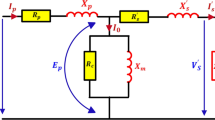Abstract
Power transformer optimal design (PTOD) is a complex multi-objective optimization problem including numerous design variables that aim to design a transformer with minimal material costs. Due to large variables search space (SS), most optimization methods proposed in the literature for PTOD are prone to find local minimum instead of the global one. So, some design variables and constraints are neglected to reduce the SS size and alleviate the problem. They also suffer from a random nature which makes it impossible for them to explore all the SS. To prevail over the aforementioned problems, this work aims to propose a new heuristic algorithm, and also, some modifications to conventional PTOD procedure. Some promising features of the proposed method in comparison with the previously proposed methods are (1) it considers all design variables as a gene for transformer constructing chromosome (TCC), (2) before building the main TCC, it divides the PTOD algorithm into some sub-algorithms and starts to construct some sub-chromosomes with lower number of genes as parts of the main TCC, which allows us to detect improper genes based on a sensitivity analysis and design constraints, and ignore them, automatically narrowing the SS by simply ignoring its bad parts (the solutions which do not meet design constraints), and (3) not only it considers all technical and consumer constrains, but it also takes manufacturing constraints into account. To verify the effectiveness of the proposed method in achieving the global minimum, it is used to design a 200 MVA and 15.75/400 KV power transformer. The validity of obtained optimal solution is further assessed by presenting comprehensive finite element method using JMAG software.












Similar content being viewed by others
Abbreviations
- S (MVA):
-
Capacity
- VPT:
-
Volt per turn
- \({N}_{\mathrm{LV}}\) :
-
Number of turns in low-voltage winding
- \({N}_{\mathrm{HV}}\) :
-
Number of turns in high-voltage winding
- \({N}_{\mathrm{Reg}}\) :
-
Number of turns in regulating voltage winding
- \({D}_{{S}}\) (mm):
-
Core diameter
- \({Q}_{{S}}\) (\(\hbox {cm}^{2}\)):
-
Cross section of core
- B (Tesla):
-
Flux density
- NL:
-
Number of layers
- H (mm):
-
Height of wire
- W (mm):
-
Width of wire
- NPR:
-
Number of radial parallel wires
- NPA:
-
Number of axial parallel wires
- NP:
-
Number of parallel wires in subdivided wires
- HW (mm):
-
Height of winding
- T (mm):
-
Width of winding
- LL (kw):
-
Load loss
- NLL (kw):
-
No-load loss
- SCI (%):
-
Short circuit impedance
References
Amoiralis I, Tsili A, Kladas AG (2009) Transformer design and optimization: a literature survey. IEEE Trans Power Deliv 24(4):1999–2024
Khatri A, Rahi OP (2012) Optimal design of transformer: a compressive bibliographical survey. Int J Sci Eng Technol 1(2):159–167
Coelho1 LS, Mariani VC, Guerra1 FA, Luz MVF, Leite JV (2015) Multi objective optimization of transformer design using a chaotic evolutionary approach. IEEE Trans Magn 50(2):669–672
Versele C, Deblecker O, Lobry J (2009) Multi objective optimal design of high frequency transformers using genetic algorithm. In: Proceedings of 13th European conference on power electronics and applications (EPE ’09)
Kulkarni SV, Khaparde SA (2004) Transformer engineering design and practice. Marcel Dekker Inc, New York
Karsai K, Kerenyi D, Kiss L (1987) Large power transformers (studies in electrical and electronic engineering), vol 25. Elsevier Co., New York
Geromel LH, Souza CR (2002) The applications of intelligent systems in power transformer design. In: Proceedings of the IEEE Canadian conference on electrical and computer engineering vol 1, pp 285–290
Amoiralis EI, Tsili MA, Kladas AG (2013) Global transformer design optimization using deterministic and non-deterministic algorithms. IEEE Trans Ind Appl. doi:10.1109/TIA.2013.2288417
Georgilakis PS, Tsili MA, Souflaris AT (2007) A heuristic solution to the transformer manufacturing cost optimization problem. J Mater Process Technol 181:260–266
Subramanian S, Padma S (2011) Optimization of transformer design using bacterial foraging algorithm. Int J Comput Appl 19(3):2677–2684
Arjona MA, Hernandez C, Cisneros-Gonzalez M (2010) Hybrid optimum design of a distribution transformer based on 2-D FE and a manufacturer design methodology. IEEE Trans Magn 46(8):2864–2867
Amoiralis EI, Georgilakis PS, Kelfalas TD, Tsili MA, Kladas AG (2007) Artificial intelligence combined with hybrid FEM-BE techniques for global transformer optimization. IEEE Trans Magn 43(4):1633–1636
Georgilakis PS (2009) Recursive genetic algorithm-finite element method technique for the solution of transformer manufacturing cost minimization problem. IET Electr Power Appl 3:514–519
Jabr R (2005) Application of geometric programming to transformer design. IEEE Trans Magn 41(11):4261–4269
Amoiralis EI, Tsili MA, Georgilakis PS, Kladas AG, Souflaris AT (2008) A parallel mixed integer programming-finite element method technique for global design optimization of power transformers. IEEE Trans Magn 44(6):1022–1025
Coelho LS, Mariani VC, Luz MVF, Leite JV (2013) Novel gamma differential evolution approach for multi objective transformer design optimization. IEEE Trans Magn 49(5):2121–2124
Georgilakis PS, Gioulekas AT, Souflaris AT (2007) A decision tree method for the selection of winding material in power transformers. J Mater Process Technol 181(1–3):281–285
Amoiralis EI, Georgilakis PS, Kefalas TD, Tsili MA, Kladas AG (2007) Artificial intelligence combined with hybrid FEM-BE techniques for global transformer optimization. IEEE Trans Mag 43(4):1633–1636
Author information
Authors and Affiliations
Corresponding author
Electronic supplementary material
Below is the link to the electronic supplementary material.
Rights and permissions
About this article
Cite this article
Yadollahi, M., Lesani, H. Power transformer optimal design (PTOD) using an innovative heuristic method combined with FEM technique. Electr Eng 100, 823–838 (2018). https://doi.org/10.1007/s00202-017-0537-z
Received:
Accepted:
Published:
Issue Date:
DOI: https://doi.org/10.1007/s00202-017-0537-z




